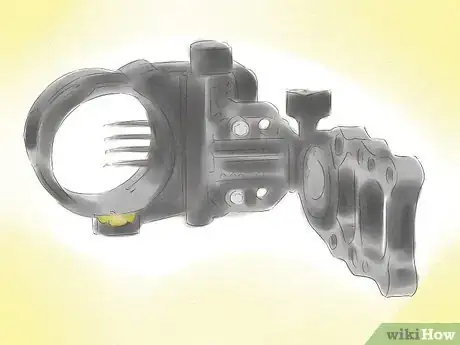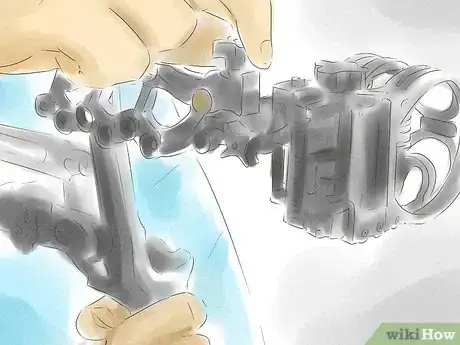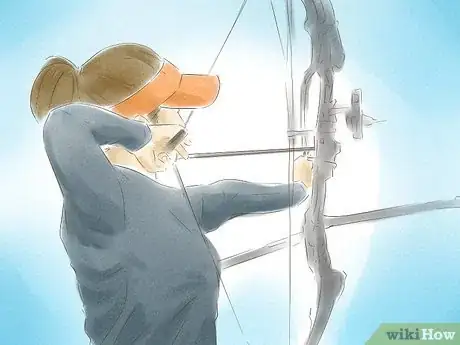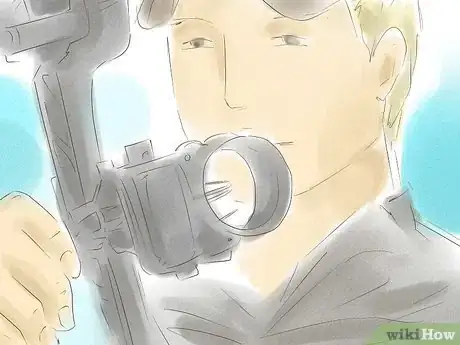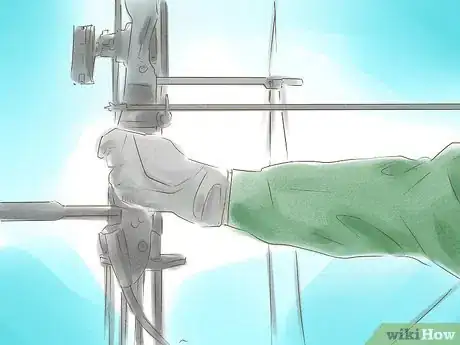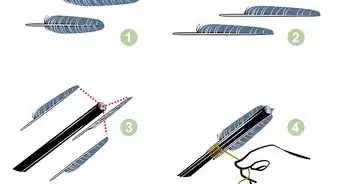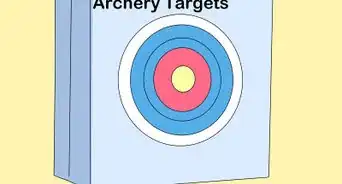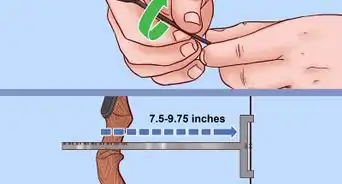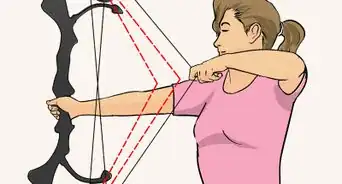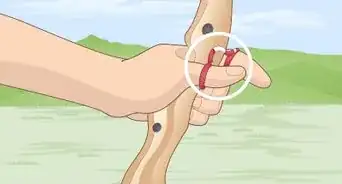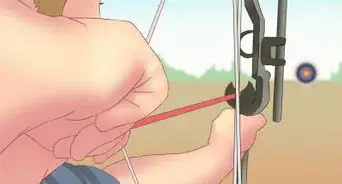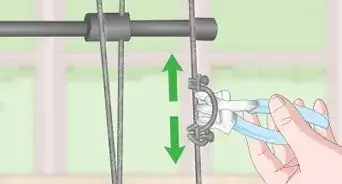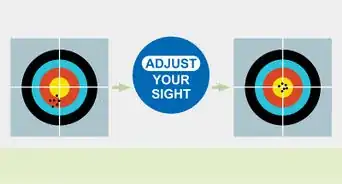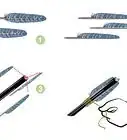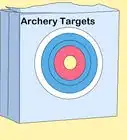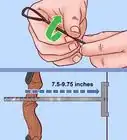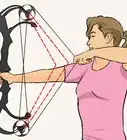wikiHow is a “wiki,” similar to Wikipedia, which means that many of our articles are co-written by multiple authors. To create this article, 14 people, some anonymous, worked to edit and improve it over time.
wikiHow marks an article as reader-approved once it receives enough positive feedback. In this case, 90% of readers who voted found the article helpful, earning it our reader-approved status.
This article has been viewed 458,273 times.
Learn more...
Archery is popular for both hunters and for those who like to practice their skills on a target range. As with any weapon, hitting a target with a bow is not easy. You cannot simply point the weapon in the general direction of the target and have any realistic hope of hitting it. The process of sighting in a bow maximizes the chances of hitting the target. Sighting in a bow allows the archer to compensate for arrow drop due to the pull of gravity over distance and disturbances caused by the firing procedure at the time of aiming. See Step 1 below to learn how.
Steps
Preparing the Bow and Range
-
1Set aside a few days. You will want to spread your sighting in over a few sessions. This is because fatigue will affect your accuracy and power, and your form will most likely shift. Spreading out the sighting over a few days will result in greater overall accuracy.[1]
-
2Buy the sight. Bow sights come in many styles and should be chosen to meet the preferences of the archer.[2] Bow sights are available at sporting good stores and specialized archery supply outlets. If you're just planning on hunting with the bow, you can use a simple sight that should only set you back around $40. Competition sights can cost 5 times this or more.
- This guide is for sighting in a fixed-pin sight. It is the most common sight and is recommended for hunting and recreation.
-
3Mount the sight to the bow. Follow the instructions provided with the sight for proper installation. Most sights are attached to the riser and are secured by a couple of screws. Most bows have pre-drilled holes for attaching sights. Do not overtighten the screws, as you could damage the bow. The sighting pins of the sight should be lined up vertically with the bow string.[3]
- The bow sight should be at a right angle to the bow.
- After installing the sight, let it settle overnight. You may have to tighten it further after it settles.
-
4Set all sighting pin adjustments to the mid-point. This will give you maximum room for adjustment in either direction as needed. An Allen wrench, available at hardware stores, will be needed to adjust the sighting pins.
-
5Set up the target and mark your ranges. Ideally you will want to be able to mark off every 10 yards (9.1 m) from the target, at least up to 40 yards (36.6 m). Use a range finder if possible for accuracy. Range finders are available from hunting and outdoor supply stores.
- Try to use a durable target that can take a lot of arrows, as sighting in the bow can take some time and a lot of repetition.
Sighting It In
-
1Set your 20 yard (first) pin. Move to the closest distance to the target, which is usually the 10 yard (9.1 m) mark. Stand so that your body is perpendicular to the target, and draw an arrow back with your bow. Look down the sight at the top pin and shoot your arrow at the target. Repeat with a few more arrows.[4]
- Take note of where the arrows hit compared to the site. If the arrows went above what the pin was indicating, move the sight box up on the bow.
- Repeat this step until the arrow is not shooting above the top pin.
- Step back to 20 yards (18.3 m). Repeat the sighting process, raising the sight box if necessary. Once the arrows are not hitting above the top pin, you can make adjustments for arrows going too far left or right by moving the sight left and right respectively.
- Don't worry about perfect accuracy yet, this pin will most likely change.
-
2Set Your 30 yard (second) pin. Once you deem your 20 yard (18.3 m) top pin suitably accurate, you can move back to the 30 yard (27.4 m) mark on your range. Aim down the sight using the second pin and fire off a few arrows at the target. Start making the same adjustments that you made while sighting in at 20 yards (18.3 m).[5]
- Remember to move the entire sight box when making adjustments at this stage.
- Take the time to make the 30 yard (27.4 m) pin as accurate as possible, because it will not be changing. This will be the anchor of your sight.
-
3Move back to 40 yards (36.6 m). Shoot arrows at the target while looking at your 40 yard (third) pin in the sight. When you make you adjustments this time, move the pin itself instead of the entire sight box. You won't be moving left and right with the sight box anymore; instead focus on making the 40 yard (36.6 m) arrow go to exactly where the pin is pointing.[6]
- The distance between the 30 and 40 yard pins will be greater than the distance between the 20 and 30 yard pins.
- If you need to readjust your left and right sight placement, return to the 30 yard (27.4 m) marker on the range and make your adjustments there.
-
4Check your 20 yard (18.3 m) shot again. Once you've set the 30 yard (27.4 m) pin and made adjustments to your 40 yard (36.6 m) pin, go back and shoot at 20 yards (18.3 m) again. This time, make adjustments to the pin itself instead of the whole sight.
-
5Move back and sight any additional pins. Depending on your sight, you may have additional pins for 50 yards (45.7 m), 60 yards (54.9 m), and more. Move back from the target and repeat the previous steps, moving the pin to make adjustments.
Community Q&A
-
QuestionDo I have to touch the bow string to my nose for a proper anchor?
 Community AnswerNo, but your nose never moves, so it typically creates a more consistent anchor point regardless of beards, face masks, gloves, etc.
Community AnswerNo, but your nose never moves, so it typically creates a more consistent anchor point regardless of beards, face masks, gloves, etc. -
QuestionWhich way do I move the sight box if the arrow shot left?
 Community AnswerYou move the sight box to the left if it is shooting left.
Community AnswerYou move the sight box to the left if it is shooting left. -
QuestionHow do I line the pin in the middle of the rear peep sight?
 Community AnswerLook through the peep sight and line the outside edge of the peep sight up with the outside edge of your front sight. Do not move your head away while focusing on the target. Put the pin to your anchor point (on the target), and you know the rest.
Community AnswerLook through the peep sight and line the outside edge of the peep sight up with the outside edge of your front sight. Do not move your head away while focusing on the target. Put the pin to your anchor point (on the target), and you know the rest.
Things You'll Need
- Bow
- Bow sight
- Arrows
- Arrow target firing range
- Range finder or distance measuring tool
- Allen wrench
References
- ↑ https://www.bowhuntingmag.com/editorial/goof-proof-tips-for-sighting-in-your-bow/310633
- ↑ https://www.bowhunting.com/bowhunt101/selecting-bow-sight/
- ↑ https://www.bowhunting.com/bowhunt101/how-to-mount-a-bow-sight/
- ↑ http://www.archerybuff.com/2011/how-to-sight-in-your-bow/
- ↑ https://www.bowhuntingmag.com/editorial/goof-proof-tips-for-sighting-in-your-bow/310633
- ↑ http://www.archerybuff.com/sightinyourbow.php
About This Article
To sight a bow in, start at the 20-yard mark, look down the sight at the top pin, and shoot your arrow. If you hit above what the pin shows, move the sight box up on your bow. You can also move the sight box left and right to adjust for hits too far to one side or the other. Keep shooting and adjusting at 20 yards until the arrows are pretty accurate, then repeat the process at 30 and 40 yards. Make any necessary adjustments to the sight box at 30 yards, but adjust the pin itself at 40 yards if you need to. Once you’re set at 40 yards, make one last check back at 20 yards, adjusting the pin if necessary. To learn how to get your bow ready and set up the range to sight your bow in, scroll down!

